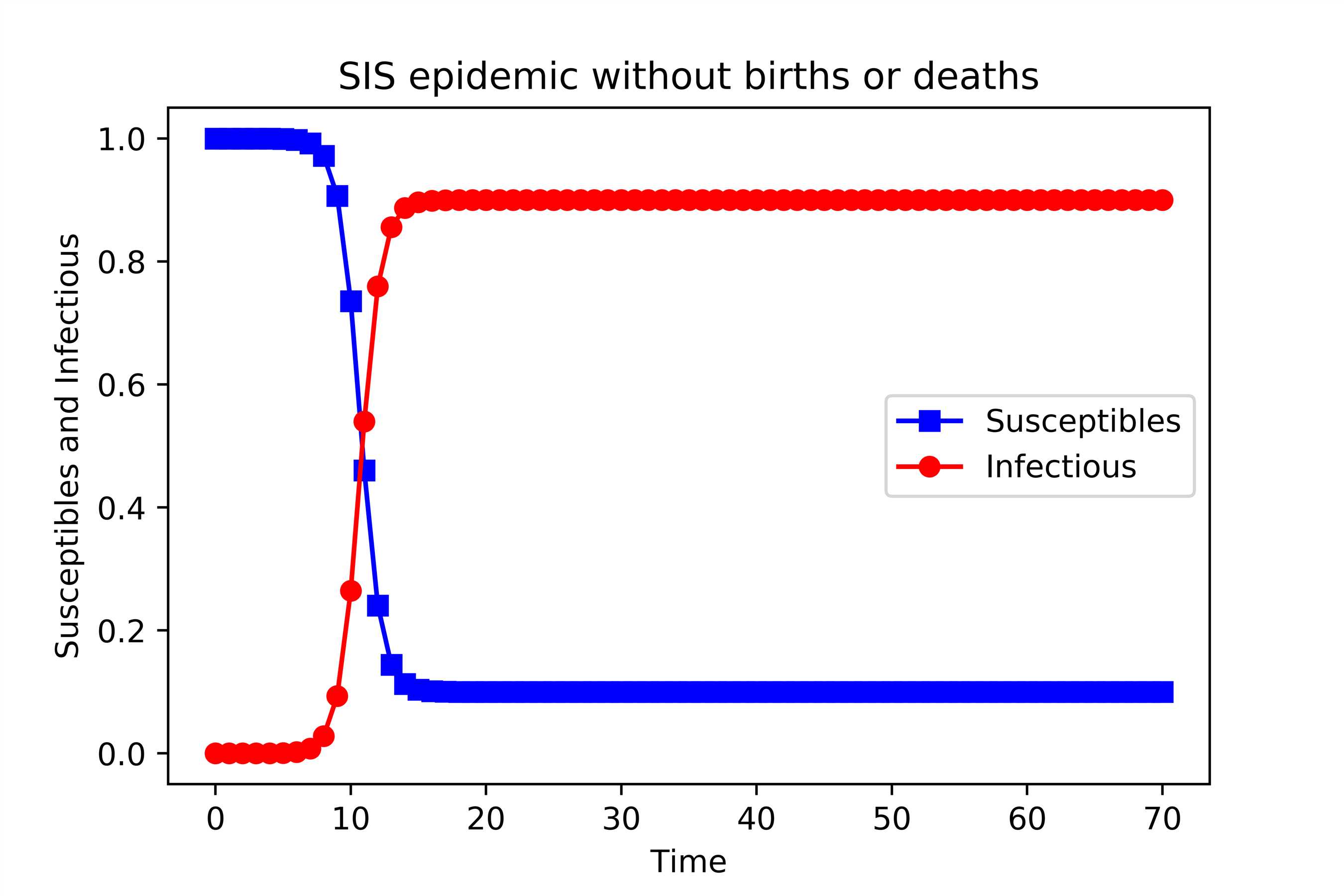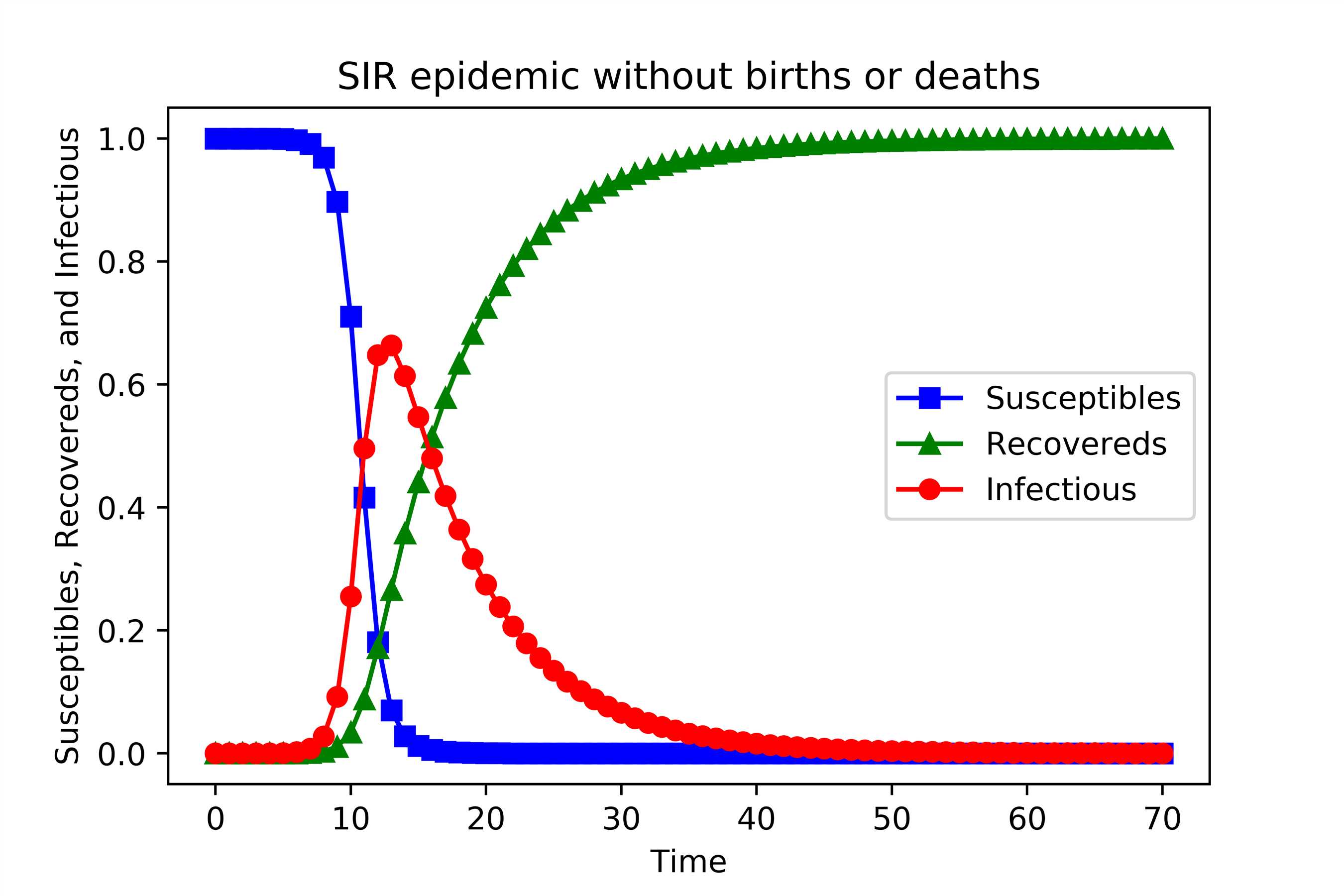标签:cheng 地方 16px import pid idt -- apt 默认
本文主要参考博客:http://chengjunwang.com/en/2013/08/learn-basic-epidemic-models-with-python/。该博客有一些笔误,并且有些地方表述不准确,推荐大家阅读Albert-Laszlo Barabasi写得书Network Science,大家可以在如下网站直接阅读传染病模型这一章:http://barabasi.com/networksciencebook/chapter/10#contact-networks。Barabasi是一位复杂网络科学领域非常厉害的学者,大家也可以在他的官网上查看作者的一些相关工作。
下面我就直接把SIS模型和SIR模型的代码放上来一起学习一下。我的Python版本是3.6.1,使用的IDE是Anaconda3。Anaconda3这个IDE我个人推荐使用,用起来很方便,而且提供了Jupyther Notebook这个很好的交互工具,大家可以尝试一下,可在官网下载:https://www.continuum.io/downloads/。
在Barabasi写得书中,有两个Hypothesis:1,Compartmentalization; 2, Homogenous Mixing。具体看教材。
默认条件:1, closed population; 2, no births; 3, no deaths; 4, no migrations.
1 # -*- coding: utf-8 -*- 2 3 import scipy.integrate as spi 4 import numpy as np 5 import pylab as pl 6 7 beta=1.4247 8 """the likelihood that the disease will be transmitted from an infected to a susceptible 9 individual in a unit time is β""" 10 gamma=0 11 #gamma is the recovery rate and in SI model, gamma equals zero 12 I0=1e-6 13 #I0 is the initial fraction of infected individuals 14 ND=70 15 #ND is the total time step 16 TS=1.0 17 INPUT = (1.0-I0, I0) 18 19 def diff_eqs(INP,t): 20 ‘‘‘The main set of equations‘‘‘ 21 Y=np.zeros((2)) 22 V = INP 23 Y[0] = - beta * V[0] * V[1] + gamma * V[1] 24 Y[1] = beta * V[0] * V[1] - gamma * V[1] 25 return Y # For odeint 26 27 t_start = 0.0; t_end = ND; t_inc = TS 28 t_range = np.arange(t_start, t_end+t_inc, t_inc) 29 RES = spi.odeint(diff_eqs,INPUT,t_range) 30 """RES is the result of fraction of susceptibles and infectious individuals at each time step respectively""" 31 print(RES) 32 33 #Ploting 34 pl.plot(RES[:,0], ‘-bs‘, label=‘Susceptibles‘) 35 pl.plot(RES[:,1], ‘-ro‘, label=‘Infectious‘) 36 pl.legend(loc=0) 37 pl.title(‘SI epidemic without births or deaths‘) 38 pl.xlabel(‘Time‘) 39 pl.ylabel(‘Susceptibles and Infectious‘) 40 pl.savefig(‘2.5-SI-high.png‘, dpi=900) # This does increase the resolution. 41 pl.show()
结果如下图所示

在早期,受感染个体的比例呈指数增长, 最终这个封闭群体中的每个人都会被感染,大概在t=16时,群体中所有个体都被感染了。
1 # -*- coding: utf-8 -*- 2 3 import scipy.integrate as spi 4 import numpy as np 5 import pylab as pl 6 7 beta=1.4247 8 gamma=0.14286 9 I0=1e-6 10 ND=70 11 TS=1.0 12 INPUT = (1.0-I0, I0) 13 14 def diff_eqs(INP,t): 15 ‘‘‘The main set of equations‘‘‘ 16 Y=np.zeros((2)) 17 V = INP 18 Y[0] = - beta * V[0] * V[1] + gamma * V[1] 19 Y[1] = beta * V[0] * V[1] - gamma * V[1] 20 return Y # For odeint 21 22 t_start = 0.0; t_end = ND; t_inc = TS 23 t_range = np.arange(t_start, t_end+t_inc, t_inc) 24 RES = spi.odeint(diff_eqs,INPUT,t_range) 25 26 print(RES) 27 28 #Ploting 29 pl.plot(RES[:,0], ‘-bs‘, label=‘Susceptibles‘) 30 pl.plot(RES[:,1], ‘-ro‘, label=‘Infectious‘) 31 pl.legend(loc=0) 32 pl.title(‘SIS epidemic without births or deaths‘) 33 pl.xlabel(‘Time‘) 34 pl.ylabel(‘Susceptibles and Infectious‘) 35 pl.savefig(‘2.5-SIS-high.png‘, dpi=900) # This does increase the resolution. 36 pl.show()
运行之后得到结果如下图:

由于个体被感染后可以恢复,所以在一个大的时间步,上图是t=17,系统达到一个稳态,其中感染个体的比例是恒定的。因此,在稳定状态下,只有有限部分的个体被感染,此时并不意味着感染消失了,而是此时在任意一个时间点,被感染的个体数量和恢复的个体数量达到一个动态平衡,双方比例保持不变。请注意,对于较大的恢复率gamma,感染个体的数量呈指数下降,最终疾病消失,即此时康复的速度高于感染的速度,故根据恢复率gamma的大小,最终可能有两种可能的结果。
# -*- coding: utf-8 -*- import scipy.integrate as spi import numpy as np import pylab as pl beta=1.4247 gamma=0.14286 TS=1.0 ND=70.0 S0=1-1e-6 I0=1e-6 INPUT = (S0, I0, 0.0) def diff_eqs(INP,t): ‘‘‘The main set of equations‘‘‘ Y=np.zeros((3)) V = INP Y[0] = - beta * V[0] * V[1] Y[1] = beta * V[0] * V[1] - gamma * V[1] Y[2] = gamma * V[1] return Y # For odeint t_start = 0.0; t_end = ND; t_inc = TS t_range = np.arange(t_start, t_end+t_inc, t_inc) RES = spi.odeint(diff_eqs,INPUT,t_range) print(RES) #Ploting pl.plot(RES[:,0], ‘-bs‘, label=‘Susceptibles‘) # I change -g to g-- # RES[:,0], ‘-g‘, pl.plot(RES[:,2], ‘-g^‘, label=‘Recovereds‘) # RES[:,2], ‘-k‘, pl.plot(RES[:,1], ‘-ro‘, label=‘Infectious‘) pl.legend(loc=0) pl.title(‘SIR epidemic without births or deaths‘) pl.xlabel(‘Time‘) pl.ylabel(‘Susceptibles, Recovereds, and Infectious‘) pl.savefig(‘2.1-SIR-high.png‘, dpi=900) # This does, too pl.show()
所得结果如下图:

基本的传染病模型:SI、SIS、SIR及其Python代码实现
标签:cheng 地方 16px import pid idt -- apt 默认
原文地址:http://www.cnblogs.com/scikit-learn/p/6937326.html